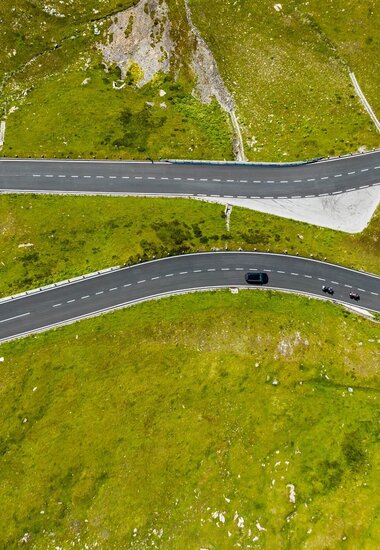Drive safety & driveability Tips for safe driving in the mountains
On a length of 48 kilometres, the Grossglockner High Alpine Road proceeds via 36, partly steep sections and lots of bends, up to Kaiser-Franz-Josefs-Höhe at 2369m. The Hochtor (2504 m), a short tunnel, links the federal states of Salzburg and Carinthia. For the most part on the Grossglockner High Alpine Road – as its name suggests – you are out and about in high Alpine terrain. The highest driveable point of the Grossglockner High Alpine Road is at 2571 metres, the Edelweiss Spitze. An access road heads up to it, which is in part still covered with the original cobbles. We have compiled a few tips for you here as to how you can enjoy your excursion on the Grossglockner High Alpine Road with the utmost safety.

Please note our current safety information and any possible blockages to sections of the road on the start page, along with the latest weather conditions that can be found on our webcams
Foresight – better than hindsight
Consider that in higher locations in particular, things happen fast, the weather may change, snow might be falling, and the road could be slippery – adapt your driving to suit the road conditions. For motorcyclists especially, a few sections of the road require a good level of fitness, driving expertise and/or experience of the mountains. To fully enjoy tours, you should not overestimate your abilities. Find out more here about all the offers, services and tips for motorcycling on the Grossglockner High Alpine Road.
Drive slower – enjoy more!
In keeping with the maxim ‘Views, not speed’ and ‘Cruising, not racing’, Grossglockner Hochalpenstrassen AG have set a speed limit of 70 km/hr on the experience roads it manages. After all, those who drive more slowly, will simply have more time to look, marvel and enjoy themselves – protecting humans and nature at the same time! More information about the themes ‘Slow Driving’ and sustainability on the Grossglockner High Alpine Road can be found here.
Better braking!
Before you set off on a journey across passes and Alpine roads you definitely ought to check your brake fluid and replace it if necessary. Tip for mountain descending: on considerable descents drop down to second, at times even first gear and use the engine brake. Drivers of automatic vehicles should set the gearshift to manual or level 1-2-3. Just take a look at your operating instructions before starting off!

Driving safety training for motorcycle and car drivers with ÖAMTC
Car and motorbike drivers are confronted with new driving conditions on the Grossglockner High Alpine Road: mist, wet conditions, snowfall and an unfamiliar road outline bring even proficient drivers to their limits. With safety training from ÖAMTC you find out key facts about proper driving and braking techniques, to how to deal with weather-related changes in road conditions.
Breakdown? It happens …
It spite of taking care and making preparations for your pleasure-filled tours, your vehicle can break down, so our road service is always by your side to assist and of course provide replacement vehicles from the automobile club.

